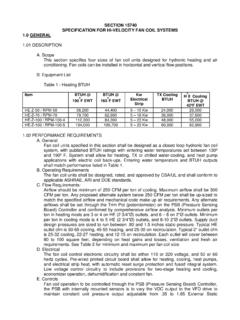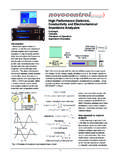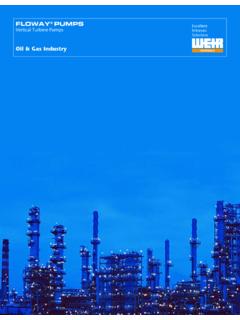Transcription of DuPont Vespel TP-8000 Series Design Handbook - …
1 SUITABLE FOR MECHANICAL COMPONENTS REQUIRING THERMAL RESISTANCE, WEAR AND FRICTION PERFORMANCE, AND high ELECTRICAL PERFORMANCEDuPont Vespel TP-8000 Series Design HandbookA number of recent innovations in both product development and fabrication technology have led to a family of thermoplastic polyimide products that offer the Design engineer practical, cost-competitive solutions to difficult problems in high temperature applications. Vespel TP-8000 Series parts are particularly adapted to applications where thermal stability, electrical properties, wear and friction behavior are required in mechanical components. Today s competitive markets place a premium on the role of the Design engineer, both in designing new products and redesigning existing ones. Vespel parts, like all plastic parts, are governed by the same rules for good Design and by the same physical laws as other materials. Therefore, the intent of this manual is to help designers apply these principles to the selection, testing and specification of Vespel TP-8000 Series parts.
2 This Design manual contains comprehensive physical property and performance data on the TP-8000 Series resins from which corresponding Vespel parts are made. All of the data in the sections that follow are the result of physical property testing conducted by DuPont or its partners. The selection of data for this manual has been made in consultation with Design engineers responsible for DuPont Vespel 8000 Series applications. End-use testing is always recommended. PageList of Tables iList of Figures iIntroduction 1 Chemistry 1 Product Overview 1 Fabrication Methods 1 Defining the End-Use Requirements 1 Prototyping the Design 2 Testing the Design 2 Writing Meaningful Specifications 3 Performance Properties 3 Mechanical Properties 3 Thermal Properties 6 Dynamic Mechanical Analysis 6 Thermal Aging 6 Flexural Creep 7 Flexural Fatigue 7 Tribological Properties 7 Electrical Properties 8 Environmental Properties 8 Chemical Exposure 8 Radiation Exposure 9 Outgassing Performance 10 Injection Molding 11 The Process and Equipment 11 The Molding Machine 11 The Mold 11 Table of Contents PageMolding Considerations 11 Uniform Walls 11 Configurations 12 Draft and Ejector Pins 13 Fillets and Radii 13 Bosses 13 Ribbing 13 Holes and Coring 14 Threads 15 External Threads 15 Internal Threads 16 Stripped Threads 16 Thread Profile 16 Threads Effect of Creep 16 Undercuts 17 Molded-In Inserts 17 Part Design for Insert Molding 18 Appendix 19 A
3 Design Check List 19 B Stress/Strain Curves as a Function of Temperature in Tension and Compression 19 C Flexural Creep 22 D Chemical Resistance Data 23 List of Tables Page 1. Typical Properties (English Units) 4 2. Typical Properties (SI Units) 5 3. Suzuki Thrust Wear Test Results Dry 8 4. Suzuki Thrust Wear Test Results Lubricated 8 5. Dielectric Constant/Dissipation Factor and Dielectric Strength 8 6. Surface and Volume Resistivity 8 7. Chemical Resistance 10 Day Immersion at 23 C 9 8. Chemical Resistance 30 Day Immersion 9 9. Property Retention after Oil Exposure at Elevated Temperature 9 10. Property Retention of TP-8054 Film after Oil Exposure 9 11. Draft Angle Allowances 13 TP 8054 Film Exposure 23 Acid Exposure 23 Refrigerant Exposure 23 List of Figures Page 1. Tensile Strength as a Function of Temperature 3 2. Flexural Strength as a Function of Temperature 3 3. Compression Strength as a Function of Temperature 3 4.
4 DMA Curve for TP-8054 6 5. DMA Curve for TP-8130 6 6. Tensile Strength Retention of TP-8054 after aging at 200 C 6 7. Elongation Retention of TP-8054 after aging at 200 C 6 8. Flexural Creep at 23 C 7 9. Flexural Fatigue 7 10. Suzuki Thrust Wear Schematic 7 11. Tensile Strength Retention after Electron Bean Exposure 10 12. Elongation Retention after Electron Bean Exposure 10 13. Tensile Elongation Retention after Gamma Irradiation Exposure (Cobalt 60) 10 14. Tensile Property Retention after Neutron Irradiation Exposure 10 15. Outgassing Performance Data 10 16. Injection Molding Machine 11 17. Plastifying Cylinder 11 18. Effects of Non-Uniform Wall Thickness on Molded Parts 12 19. External Radius Illustration, Uniform Wall 12 20. Design Considerations for Maintaining Uniform Walls of Ribs and Bosses 12 21. Additional Uniform Wall Considerations 12 22. Wall Thickness Transition 12iList of Figures (continued) Page 23. Stress Concentration Factors for a Cantilevered Structure 13 24.
5 Use of External or Internal Radii 13 25. Boss Design 14 26. Additional Boss Design Details 14 27. Cored Holes 14 28. Counterboring Holes 14 29. Additional Cored Hole Details 15 30. Drilled Holes 15 31. Hole Design 15 32. Blind Holes 15 33. Molding External Threads without Side Core 16 34. Stripping of Roll-Type Threads 16 35. Mold Ejection of Rounded Thread-Form Undercuts Male 16 36. Mold Ejection of Rounded Thread-Form Undercuts Female 16 37. Correct Termination of Threads 17 38. Suggested End Clearance on Threads 17 39. Suggestions for Designing Threaded Assemblies of Metal to Plastic 17 40. Undercuts 17 41. Boss Design Details for Insert Molding 18 42. Insert Design Details 18A-1 Design Check List 19B-1 TP-8054 Stress/Strain in Tension 19B-2 TP-8395 Stress/Strain in Tension 19B-3 TP-8212 Stress/Strain in Tension 19B-4 TP-8130 Stress/Strain in Tension 20B-5 TP-8311 Stress/Strain in Tension 20B-6 TP-8549 Stress/Strain in Tension 20B-7 TP-8792 Stress/Strain in Tension 20B-8 TP-8054 Stress/Strain in Compression 20B-9 TP-8395 Stress/Strain in Compression 20B-10 TP-8212 Stress/Strain in Compression 21B-11 TP-8130 Stress/Strain in Compression 21B-12 TP-8311 Stress/Strain in Compression 21B-13 TP-8549 Stress/Strain in Compression 21B-14 TP-8792 Stress/Strain in Compression 21C-1 TP-8054 Flexural Creep 22C-2 TP-8395 Flexural Creep 22C-3 TP-8212 Flexural Creep 22C-4 TP-8130 Flexural Creep 22C-5 TP-8311 Flexural Creep 22C-6 TP-8549 Flexural Creep 22C-7 TP-8792 Flexural Creep 22ii INTRODUCTIONC hemistryDuPont Vespel TP-8000 Series is a group of products based on semi-crystalline polyimide having a Tg of 250 C and
6 A Tm of 388 C. However, the molded products are amorphous because the crystallization speed is slower than that of typical semi-crystalline polymers. TP-8000 can be used up to 240 C in the as-molded amorphous state, whereas it can be used above 240 C up to 320 C when crystallized after molding. However, since maximum use temperature is dependent on a number of factors, contact your local Vespel Technical resource for Overview The TP-8000 Series includes several different products that cover a wide array of high temperature and high wear applications. The table below gives a brief overview of the product offering. While this Design manual covers these standard TP-8000 grades, several specialty grades are available. Please contact your local Vespel Technical resource to discuss your specific application in more detail so that a suitable TP-8000 Series product can be Methods Since TP-8000 Series products are thermoplastic, they can be fabricated into articles using melt processing techniques such as injection molding, extrusion, and thermoforming.
7 This geometric Vespel TP GradeNominal CompositionPerformance OverviewTypical ApplicationsTP-8054 UnfilledGeneral purpose unfilled grade used in insulating applicationsElectrical bushings, thermal and electrical Insulator rings and pads, connectors, switchesTP-8395 PTFE, Graphite BlendUsed for wear applications where the countersurface is highly polished or a soft metalWear rings, washers, seal ringsTP-821230% Glass FilledHigh modulus grade used in insulating applications that do not require wear resistance (Glass is aggressive towards countersurface).Brackets, thermal and electrical insulatorsTP-813030% Carbon Fiber FilledInternally lubricated, high modulus grade used in both dry and lubricated wear washers, bushings bearings, wear pads and stripsTP-831110% Carbon Fiber FilledMedium modulus grade used in both dry and lubricated wear environmentsFairings, wear strips and pads, TP-854930% Carbon Fiber FilledHigh modulus grade similar to TP-8130 but offers improved wear performance and chemical washers, bushings bearings, wear pads and stripsTP-879215% Carbon Fiber, 15% PTFE FilledSimilar in strength to TP-8311 with better wear resistance at high speeds in lubricated environmentsSeal rings, piston rings, vanesflexibility gives Design engineers unprecedented freedom to creatively solve most Design problems without the added cost of a secondary machining operation.
8 Furthermore, given the geometric flexibility that comes with these products, multiple components may be incorporated into a single part, reducing tooling, inventory and part handling costs. When metal or ceramic mating components are required, insert-molding Vespel TP is always an option-adding more Design flexibility and overall part functionality. Defining the End-Use RequirementsThe most important first step in designing a plastic part is to define properly and completely the environment in which the part will operate. Properties of plastic materials are substantially altered by temperature, chemical exposure, and applied stress. These environmental effects must be defined on the basis of both short and long term exposure conditions. Time under stress and environment is important in determining the extent to which properties, and thus the performance of the part will be affected. If a part is to be subject to temperature changes in the end-use, it is not enough to define the maximum temperature to which the part will be exposed.
9 The total time the part will be at that temperature during the Design life of the device must also be calculated. The same applies to stress resulting from an applied load. If the stress is applied intermittently, the time it is applied and the frequency of occurrence is very important. Plastic materials are subject to creep under applied stress and the creep rate is accelerated with increasing temperature. If loading is intermittent, the plastic part will recover to some extent, depending upon the stress level, the duration of time the stress is applied, the length of time the stress is removed or reduced, and the temperature during each time period. The effect of chemicals, lubricants, etc., is likewise time and stress dependent. Some materials may not be affected in the unstressed state, but will stress crack when stressed and exposed to the same reagent over a period of time. A Design checklist is included in Appendix A to serve as a guide when defining the end-use the DesignIn order to move a part from the Design stage to commercial reality, it is often necessary to produce prototype parts for testing and modification.
10 The preferred method for making prototypes is to simulate as closely as practical the same process by which the parts will be made in commercial production. Most engineering plastic parts are made in commercial production via the injection molding process, thus, the prototypes should be made using a single cavity prototype mold or a test cavity mounted in the production mold base. The reasons for this are sound, and it is important that they be clearly understood. The discussion that follows will describe the various methods used for making prototypes, together with their advantages and from Rod or Plaque StockThis method is commonly used where the Design is very tentative and a small number of prototypes are required, and where relatively simple part geometry is involved. Machining of complex shapes, particularly where more than one prototype is required, can be expensive. Machined parts can be used to assist in developing a more firm Design , or even for limited testing, but are not recommended for final evaluation prior to commercialization.









